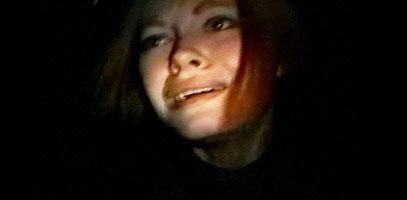
The Collingswood Story (Movie Review)
For better or worse, horror is probably the most gimmick-friendly genre. From William Castle blurring the line between cinemas and funhouses to Ruggero Deodato pulling a publicity stunt that ended with him facing homicide charges all the way up to today’s digital 3D and First Person POV movies, it’s sometimes hard to tell what came first, the gimmick or the movie.
I have nothing against a good gimmick. I like to think that if you trace the DNA of the horror genre back far enough you’ll find at least some roots in the shysters who ran carnival side shows and convinced people to part with their hard earned money to see an “Alligator Man” who was really just some poor guy with a skin condition and or a “mermaid” made out of a monkey sewn onto a fish. As annoying as they can be, if you took cheap scares, crazy plot twists and brilliantly stupid experiments out of horror films, you’d take a lot of the fun out as well.
The problem is, no matter how clever a gimmick is, you can’t float a bad movie on it. Case in point, “The Collingswood Story”. The gimmick: the entire movie is told entirely through webcam footage. As far as gimmicks go, that’s pretty brilliant, especially for an indie filmmaker looking to make a zero budget film. So the movie looks like crap and all the shots are static… well, that’s what webcams look like. It’s realism, baby. This knife cuts both ways, though. If it can’t get by on looks, a film better have a good story or an effective atmosphere or strong actors or it’s going to get tedious and boring really quickly. “The Collingswood Story” strikes out on all three counts.
John and Rebecca are a couple straight out of a John Cougar Mellencamp song. Rebecca has recently left their small Virginia hometown to go to university in Collingswood, NJ. John has stayed behind with his burnout friends to wear backwards baseball caps and work on cars or something. To stay in touch (and aid his long-distance stalking), John gives Rebecca a webcam for her birthday. As part of her present, he throws her privacy concerns and safety to the wind and gives her contact information a number of webcam freaks including a half-naked homeless Santa lookalike, a tone-deaf ukulele player and a low rent psychic named Vera Madeline.
In the course of her conversations with Vera Madeline, Rebecca learns about a child-killing Satanic cult that started in Collingswood. John does some more research and finds out that the house Rebecca has just moved into was the site of a vicious murder-suicide just a few years before. For some unfathomable reason, he decides to tell Rebecca everything he’s learned about the brutal murders that took place in the bathtub of the house she is currently staying in all by herself just before she goes to bed. As the two of them begin to piece together what happened, Rebecca finally decides to find out the truth by climbing up into the attic and reenacting the final scenes of “The Blair Witch Project”.
It’s impossible to talk about this movie without bringing up “The Blair Witch Project” because “The Collingswood Story” is so clearly patterned after it. Any “Blair Witch” haters who doubt the skill and magic that went into that movie just need to give this flick a watch and they’ll see a clear difference. The backstory has all the depth of a particularly grisly episode of Scooby-Doo and the “surprise ending” isn’t just a cheap twist- it breaks the movie to the point where it doesn’t make any sense. I’m a well-documented hater of just about any twist that doesn’t have Rod Serling narrating, but the ending of this movie is so cheap and unearned that I want to beat the screenwriter with a rolled-up copy of his script until he can explain away the numerous plotholes opened up by the moronic twist.
Maybe “The Collingswood Story” was just ahead of its time. It was made in 2002, well before webcams became a normal part of everyday life, a fact which is apparent in the clunky, bizarro-world use of the cams. I’m not too hip on where webcam technology was 7 years ago, but it’s odd to see people dialing telephones to connect to what they call “phone cams”, as well as having to use extra-long telephone wires to stay connected. It also doesn’t help that for much of the movie we’re staring at a tiny video window in an ugly made-up webcam software interface on an ugly fake Windows 95 desktop. I guess it’s a testament to Moore’s Law that a seven year old movie feels as outdated as a Buck Rogers serial.
Despite the thrashing I’ve given it, I really wanted to like “The Collingswood Story”. At the risk of sounding too much like my high school guidance counselor, there’s a lot of wasted potential in the premise. The idea of a haunted house movie told through webcams could be a winner, even though it might be better served in a short or an anthology segment, but when it’s tied to a movie that is only interested in aping “The Blair Witch Project” and culminates in an ending that is little more than an inexplicable, story-breaking jump scare, you’re better off spending 80 minutes watching YouTube videos than this poorly conceived gimmick with a movie attached.

